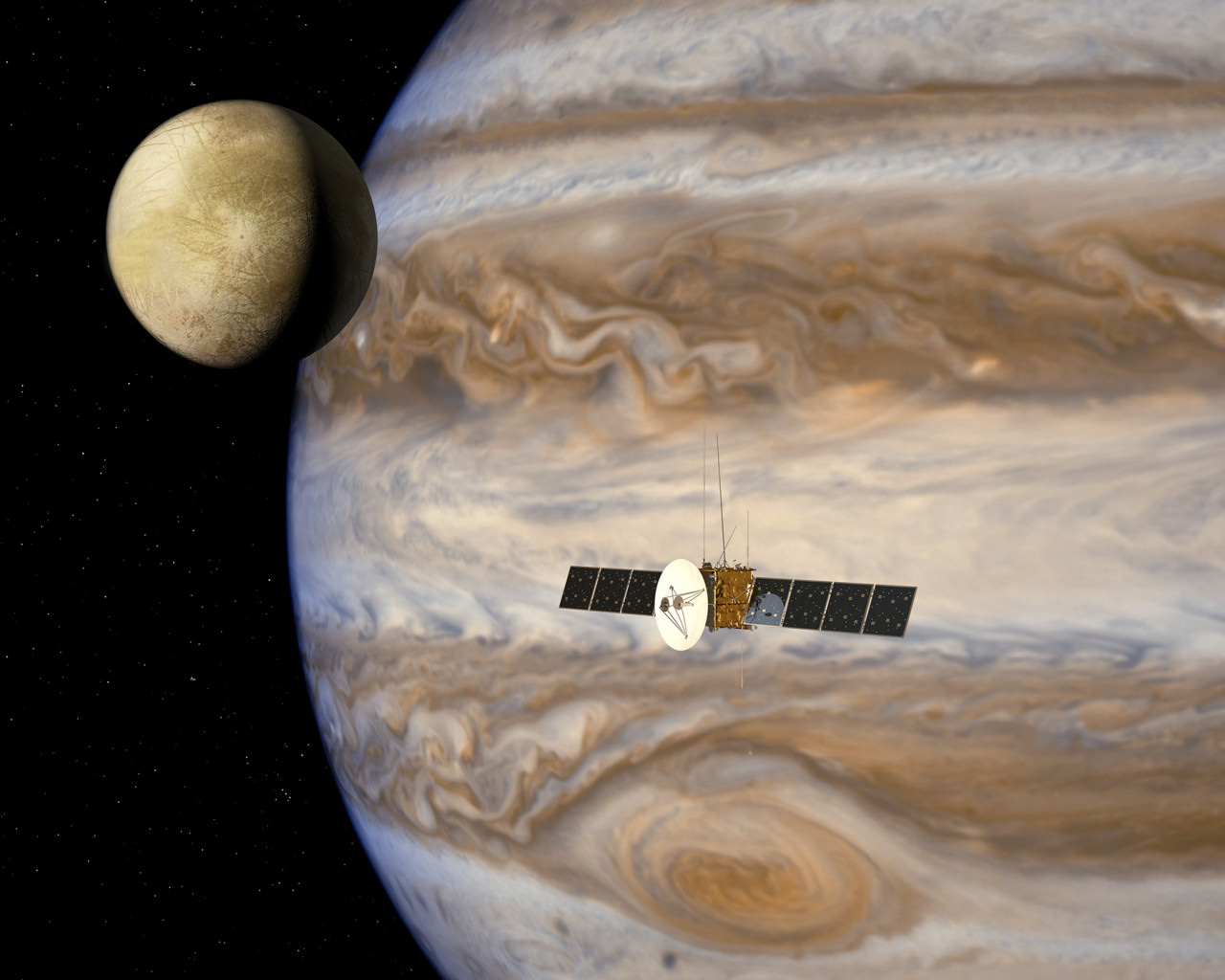
The detailed study of Jupiter’s fascinating large, icy moons got a step closer with the formal adoption of the European Space Agency’s JUpiter ICy moons Explorer mission, or JUICE, by the agency’s Science Programme Committee, earlier this month. This latest development marks a major milestone for the JUICE mission, allowing it to proceed toward implementation in order to meet its scheduled launch date in 2022.
Prior to the advent of the Space Age, astronomers believed the moons of the gas giant planets in the outer Solar System were mostly boring chunks of rock and ice. Conventional wisdom held that so far from the Sun, every Solar System body would be a denizen of a vast, icy planetary graveyard. NASA’s twin Voyager 1 and 2 spacecraft which flew by the gas giant planets during their Grand Tour of the outer Solar System in the 1970s and ’80s revealed a very different picture, however, sending back pictures which showed an assortment of dynamic, active, and ever-changing moons, orbiting their equally fascinating planets in set-ups that could best be described as mini solar systems in their own right. Following up on the exciting discoveries of the Voyager probes, NASA’s Galileo spacecraft further revolutionized our knowledge of Jupiter in the 1990s, with some of the mission’s greatest findings concerning the planet’s four largest moons—Io, Europa, Ganymede, and Callisto—which were found to be much more fascinating and diverse than previously thought. Highlights include the observations of Io’s continuing resurfacing by volcanic activity, the very strong evidence for the presence of global underground water oceans on Europa, Ganymede, and Callisto, as well as the discovery that Ganymede, the largest moon in the Solar System, has its own magnetosphere which is three times larger than that of Mercury—a feature that is unique among the Solar System’s hundreds of moons.
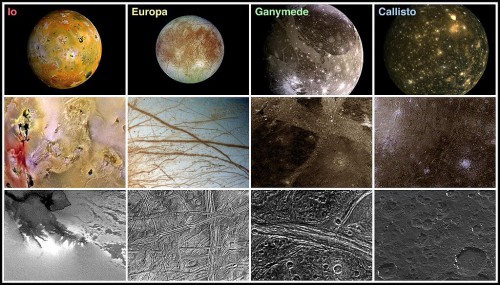
The spectacular discoveries by the Galileo mission led to a paradigm shift in our view of the outer Solar System, as well as to our concept of habitability. Whereas previously thought as being too hostile to harbor life as we know it, Europa, Ganymede, and Callisto are now largely seen as objects of prime astrobiological interest in the search for extraterrestrial life, with many scientists arguing that these distant moons may even have a much greater potential than Mars for harboring life today. Furthermore, the Jovian system with its largely diverse moons is seen as an archetype for the way that other gas giant exoplanets and exomoons form and evolve elsewhere in the galaxy. ”Jupiter and its icy moons constitute a kind of mini-Solar System in their own right, offering European scientists and our international partners the chance to learn more about the formation of potentially habitable worlds around other stars,” says Dmitry Titov, JUICE Study Scientist at the Max Planck Institute for Solar System Research in Germany.
For these reasons, which have rendered the in-depth study of the Jovian system a high scientific priority, there hasn’t been a shortage of proposed mission concepts throughout the years for sending an advanced robotic spacecraft to Jupiter and its moons, with none of them advancing beyond the definition phase. One such mission concept was the Europa Jupiter System Mission-Laplace, or EJSM-Laplace for short, which was part of an ambitious joint NASA/ESA Outer Planets Flagship Mission program that had been formulated in early 2008 and called for the in-depth study of the icy satellites of Jupiter and Saturn. More specifically, the goal of the EJSM-Laplace mission was the detailed exploration of Jupiter’s large Galilean moons with a specific focus on Europa and Ganymede. The EJSM-Laplace mission architecture consisted of a Jupiter Europa Orbiter and a Jupiter Ganymede Orbiter that were to be built by NASA and ESA respectively and launched independently within the 2018-2020 timeframe, while also leaving the door open for international cooperation with Russia and Japan to contribute their own orbiters and landers as well. Sadly, by early 2011 it had become obvious that the EJSM-Laplace mission could not be implemented as envisioned, due to NASA’s chronic budgetary constrains that eventually forced the agency to also back out of its joint ExoMars mission with ESA the following year. This development led the European Space Agency to reformulate the EJSM-Laplace mission as a solely European endeavor with minimal international participation, while preserving the original science goals of the Jupiter Ganymede Orbiter concept. This reformulation process eventually gave rise to the JUICE mission proposal, which was selected in May 2012 as the first Large-class (L1) mission in the agency’s Cosmic Vision 2015–2025 Science Program.
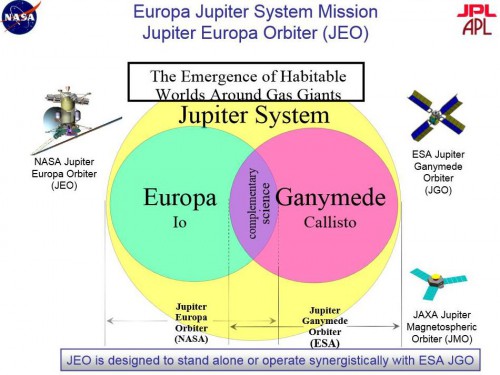
The goal of the JUICE mission as laid out by its science study team is to address two major questions: a) What are the conditions for planet formation and the emergence of life? and b) How does the Solar System work? To that end, JUICE aims to fully characterize Europa, Callisto, and Ganymede, with a special emphasis on the latter, in order to shed more light to the conditions that may have led to the development of potentially habitable environments in their underground oceans. Furthermore, JUICE will also study the interaction of Jupiter’s atmosphere and magnetic filed with all four of the Galilean satellites, and determine the gravitational and tidal interactions between the satellites themselves, which will provide scientists with great insight into the dynamics of the Jovian system as a whole.
To that end, JUICE will be equipped with an advanced science payload suite that will consist of 11 instruments, which were announced by ESA’s Science Programme Committee in February 2013. These include:
— The Jovis, Amorum ac Natorum Undique Scrutator, or JANUS, an optical camera to study global, regional and local morphology and processes on the Galilean moons, and to perform mapping of the clouds on Jupiter.
— The Moons and Jupiter Imaging Spectrometer, or MAJIS, a hyper-spectral imaging spectrometer for observing tropospheric cloud features and minor species on Jupiter and for the characterisation of ices and minerals on the surfaces of icy moons.
— A UV imaging Spectrograph, or UVS, to characterise the composition and dynamics of the exospheres of the icy moons, to study the Jovian aurorae, and to investigate the composition and structure of the upper atmosphere. The instrument will perform both nadir observations and solar and stellar occultation sounding.
— The Sub-millimeter Wave Instrument, or SWI, to investigate the temperature structure, composition and dynamics of Jupiter’s stratosphere and troposphere, and the exospheres and surfaces of the icy moons.
— The GAnymede Laser Altimeter, or GALA, for studying the tidal deformation of Ganymede and the morphology and topography of the surfaces of the icy moons.
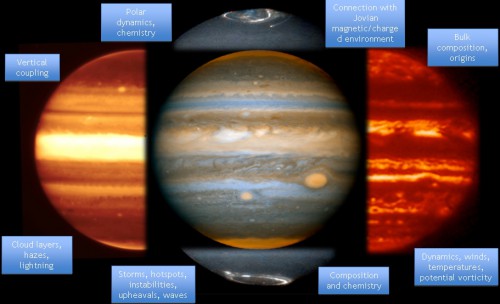
— The Radar for Icy Moons Exploration, or RIME, an ice penetrating radar to study the subsurface structure of the icy moons down to 9 km depth with vertical resolution of up to 30 m in ice.
— The J-MAG, a magnetometer to characterise the Jovian magnetic field, its interaction with the internal magnetic field of Ganymede, and to study subsurface oceans of the icy moons.
— The Particle Environment Package, or PEP, a plasma package with sensors to characterise the plasma environment in the Jovian system.
— The Radio & Plasma Wave Investigation, or RPWI, to characterise the radio emission and plasma environment of Jupiter and its icy moons.
— The Gravity & Geophysics of Jupiter and Galilean Moons, or 3GM, a radio science package comprising a Ka transponder and an ultra stable oscillator that will be used to study the gravity field – up to degree 10 – at Ganymede and the extent of internal oceans on the icy moons, and to investigate the structure of the neutral atmospheres and ionospheres of Jupiter (0.1 – 800 mbar) and its moons.
— The Planetary Radio Interferometer & Doppler Experiment, or PRIDE, which will use the standard telecommunication system of the JUICE spacecraft and VLBI – Very Long Baseline Interferometry – to perform precise measurements of the spacecraft position and velocity to investigate the gravity fields of Jupiter and the icy moons.
Most of the instruments on board JUICE will be designed and built by scientific teams from 16 different ESA member states, including Austria, Belgium, Czech Republic, Finland, France, Germany, Greece, Hungary, Ireland, Italy, Netherlands, Poland, Spain, Sweden, Switzerland, and the U.K. Nevertheless, NASA will make some key contributions to the mission by designing the spacecraft’s Ultraviolet Spectrometer instrument and providing several hardware components for the RIME and PEP instruments as well. The University of Tokyo’s Earthquake Research Institute in Japan rounds up the list of international contributions, with its involvement on the GALA instrument. JUICE is expected to cost ESA a total 880 million euro ($1.1 billion) while NASA’s financial contribution has been calculated to be about $100 million throughout the entire duration of the mission from initial design to its end of operations in the early 2030s.
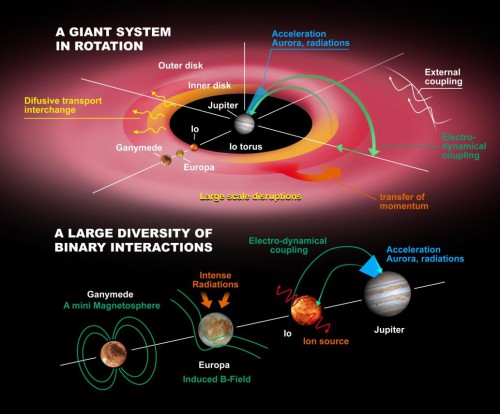
In order to be able to function in the vicinity of Jupiter, where it will be receiving less than 5 percent of the sunlight that it would on Earth, JUICE will be powered by two large solar panels that will be generating a total of 900 W, making it only the second mission after NASA’s Juno spacecraft (which is already en route toward the giant planet) to use solar arrays for generating power that far from the Sun. Facing no shortage of available energy, JUICE will use its comprehensive set of science instruments in order to conduct the most extensive and systematic study ever of the Jovian system, allowing scientists to answer fundamental questions regarding the evolution and possible habitability of its icy satellites. “The suite of instruments addresses all of the mission’s science goals, from in-situ measurements of Jupiter’s vast magnetic field and plasma environment, to remote observations of the surfaces and interiors of the three icy moons,” Luigi Colangeli, head of ESA’s Solar System Missions Division said in a statement.
Following its scheduled launch on top of an Ariane 5 ECA rocket in June 2022 (with a backup launch window also available in August 2023), JUICE will begin an eight-year journey through the Solar System in order to conduct three gravity assist flybys of Earth and one of Venus, which will give the spacecraft the necessary velocity to finally reach Jupiter in January 2030. Once there, JUICE will conduct a highly critical Jupiter Orbit Insertion maneuver which will allow it to be captured by the giant planet’s massive gravity and set it into a carefully planned 11-month-long transfer orbit toward Callisto, that will commence the “Europa phase” of the mission. The latter will include two close flybys of the enigmatic moon, with the spacecraft getting as close as 400 km to its icy surface, allowing it to obtain very high-definition views of selected sites of interest, characterize their non-ice organic and inorganic material, and search for underground liquid water down to 9 km below the surface with its ice-penetrating radar. Similar studies, albeit to a greater extend, will be conducted of Callisto and Ganymede as well, during a series of more than 20 flybys of these icy moons. Ganymede in particular, which will comprise JUICE’s primary science target, will be studied extensively during the last nine months of the mission, prior to its end of operations in June 2033, with the spacecraft approaching the moon as close as 500 km above the surface.
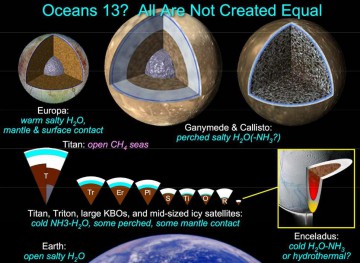
But before all this can take place however, JUICE must undergo a rigorous, multi-phase development process here on Earth first. To that end, the mission recently ticked off another milestone on its long road toward the launch pad by gaining approval to advance toward implementation, during a meeting at the European Space Astronomy Centre, or ESOC, in Spain, which took place on 19 and 20 November. The start of the implementation phase clears ESA to select a prime contractor for the mission by September 2015, following an open competition, who will be responsible for the design, manufacturing, integration, testing, and assembly of the spacecraft. From there on, the next major milestones in the mission’s development process are the Preliminary Design Review, which is expected to take place in the first quarter of 2017, and the Critical Design Review two years later, leading to the Flight Acceptance Review which, providing that everything goes according to plan, will eventually clear the mission for launch in June 2022.
Despite not being able to directly detect any forms of life on Jupiter’s icy moons, the JUICE mission will revolutionize our view of the Jupiter system in similar fashion to the Voyager and Galileo missions in previous decades. “What we’re looking for with this mission, is habitability rather than looking for life,” said Dr. Andrew Coates, member of the Juice Science Study team at the University College London, in an interview. “We’re looking for the ingredients for life and whether they could exist within our own Solar System. At the moment we don’t know of any life elsewhere in the Universe, but when conditions are right from a scientist’s perspective there’s absolutely no reason why there shouldn’t be life. So, my hunch is that we might find something really exciting in the Jupiter system.”
If the history of planetary space exploration is any indication, JUICE is poised to be one of the most important planetary science missions of the 2030s.
Want to keep up-to-date with all things space? Be sure to “Like” AmericaSpace on Facebook and follow us on Twitter: @AmericaSpace




Great news! Go!